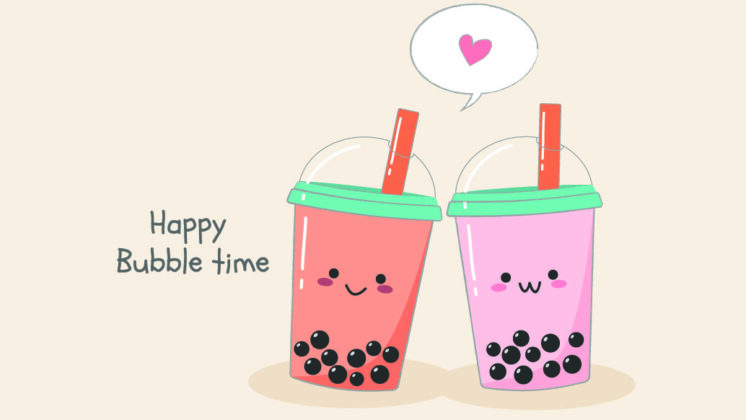Japan loves food. From gourmet popcorn and rainbow towers of shaved ice to Korean hot dogs and even artisan toast, crowds of hip young Japanese men and women are always looking for the next hot (or cold) delicacy.
The latest trend? Tapioca.
Known as “bubble tea” or “boba tea” in Taiwan, where it was invented in the 1980s, these tea-based drinks are all the rage across Japan this summer—for the third time.
Japan’s first tapioca boom came in 1992. Back then, it was the small, white pearls in coconut milk that had people lining up for a taste. Tapioca was still relatively unknown in the Japanese market at the time, but managed to gain popularity through TV spots and other media.
The second round of Japanese tapioca interest came in a smaller boom around 2008, this time arriving with a more pronounced Taiwanese flare and the iconic large, dark pearls in tea we see today.
Now, eleven years later, a third craze has exploded across the country, finding a new market and massive interest.
Three tapioca booms, each a little different. Is it possible that tapioca is satisfying different customer needs over time? For the answers, we can look to a theory of human motivation that’s been in use for over fifty years: Maslow’s Hierarchy of Needs.
Next Article
How to Lead with Empathy through Maslow’s Hierarchy of Needs
3 Ways the MECE Principle Makes Data Organization Easy
The Logic Tree: The Ultimate Critical Thinking Framework
Maslow’s Hierarchy of Needs through Tapioca Goggles
Abraham Maslow developed his Hierarchy of Needs in 1943 to explain human motivation and behavior. According to the theory, human needs are categorized into five tiers: physiological, safety, social, esteem, and self-actualization. People generally (though not always) act to meet higher level needs as lower-level needs are met, moving up the hierarchy tier by tier.
From a Maslow perspective, the first and current tapioca booms (the larger of the three) are meeting different needs in the Japanese market.

The First Boom
The initial boom of 1992 took place long before social media—even before most people had mobile phones. Cell phone market penetration was just 1.4%, according to NTTCom Online Marketing Solutions. At the time, traditional mass media (TV and magazines) were responsible for spreading the good news of tapioca. Young people, especially, took up the call, eager to be part of the latest trends.
Looking at these factors and comparing them to Maslow’s Hierarchy, the first tapioca boom fit the social needs of the young demographic—that is, the need to be part of a group, feel loved, and have friendships. In short, tapioca in the Japan of 1992 enabled people to achieve a sense of belonging.
It is this same social desire that led to the development of social media years later. Platforms such as Facebook and Twitter created new, diverse communities on an unprecedented scale. People with the same hobbies, education, and such could suddenly connect from across the globe. Or sometimes, the connection bridges a different kind of distance. Most people these days have used social media to reunite with old friends or colleagues, rejoining a social circle that may have otherwise been lost.
Maslow identifies all that as the need for belonging.
The Third Boom
The first boom was entirely driven by outside traditional media influence, but now, in the third boom, social media is enabling customers to get in on the action themselves and fulfill the next tier up in the hierarchy: esteem. According to Maslow, this has to do with feeling appreciated and respected.
It all started with a famous Taiwanese bubble tea vendor entering the Japanese market. The main vehicle for their success? Instagram. Posting pictures of food (and selfies with food) has become a way for people to earn likes on Instagram, Facebook, and similar platforms. A simple search for #Tapioca on Instagram will find a whopping 1.18 million posts as of September 2019, and that number is growing by the day.
Top-notch selfies on social media lead to more likes, which lead to more friends and followers, which leads to a sense of esteem.
And tapioca vendors haven’t missed the fact that visual appeal means bigger sales. This time around, they’re taking care to enhance how their drinks look on camera. Tapioca, a starch extracted from the root of the cassava plant, is naturally white. That’s hardly ideal for a selfie when buried in a milky drink. For this reason, vendors have come to soak tapioca in brown sugar to change its color to dark brown and really make it pop.
Clearly, it’s working.
The Depth of Tapioca Love
Whenever social media gets involved, a question inevitably follows: Is it really healthy for so many people to focus on what others think of them? Social media burnout is a real thing. It’s connected to exhaustion, addiction, depression and other clinical disorders rising in today’s society. The endless hunt for outside approval has a clear downside. So if this third tapioca boom is all about getting likes on Instagram, is that actually helping anyone?
For the answer, we need to check back in with Maslow.
At the top of Maslow’s Hierarchy of Needs is self-actualization, the fulfillment of ambitions and personal development toward the best version of ourselves. In this stage, we need look inward and recognize our own views and values, to take action toward realizing our ideal worldview. Put another way, to reach self-actualization, we need to rule ourselves. This, says Maslow, is how we become truly happy.
With such a heavy reliance on likes, it seems Japan’s third tapioca boom is allowing us to be ruled by outside input. But is it possible that selfies are a stepping stone to something greater? Something that can lead to self-actualization?
There is some evidence to that effect. Thanks to this tapioca boom, some people are discovering a love of photography—even becoming professional photographers as a result. Others become interested in desserts and begin to study store management, hoping to open their own shop one day.
With the right mindset to step beyond endlessly gathering likes, some people are taking charge of their lives and pursuing self-actualization. And it’s all thanks to new technology, transforming social norms, and tapioca.






